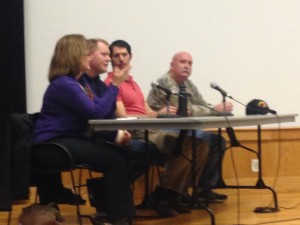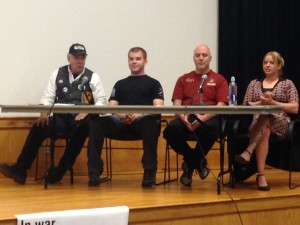“There’s light at the end of the tunnel, you just have to find it. But no matter how successful you get, it will always stay with you,” said marine veteran Erik Watkins.
He was talking about PTSD.
The National Center for PTSD says that a post-traumatic stress disorder begins when someone goes through, sees, or learns about a traumatic event like combat exposure, sexual or physical abuse, terrorist attack, sexual/physical assault, serious accident or a natural disaster.
Persons suffering from PTSD often relives the event (re-experiencing), avoids situations that remind them of the event, have negative changes in beliefs and feelings, or feel keyed up (hyperarousal). They experience fear or anxiety, sadness or depression, guilt and shame, anger and irritability, and behavior changes.
Watkins, like many veterans, still has the flashbacks, nightmares but with that the understanding how the tunnel works and how to handle it.
It took Cody Wooldridge two years to realize he could walk across his front yard and walk on unpaved roads without being in danger.
“Becoming human again, it what I describe it as,” said Wooldridge.

The discussion involved a group of six veterans, some who have been in combat and some who have not. One this side from left to right Kim Woodard, Cody Wooldridge, Erik Watkins, and Darwin Thomas.
Photo by Christina Jackson.
According to the U.S. Department of Veteran Affairs PTSD: National Center for PTSD 15 percent of Vietnam veterans were diagnosed with PTSD in the 1980s at the time of the study. It is estimated from the National Vietnam Veterans Readjustment Study (NVVRS, the same study estimated that 30 percent of Vietnam veterans have had PTSD in their lifetime.
Kimberly S. Gorman, Ph.D., HSP-P, and Director of WCU’s Counseling Psychological Services (CAPS) works with several veterans from the Vet to Vet program and advises that anyone who recognizes they have PTSD should seek help immediately.
“The diagnosis itself necessitates that at least one month of symptoms have been present. This means that the individual has already been struggling with significant symptom distress for a while. Unfortunately, however, many individuals with PTSD do not seek treatment as they know that the likely process of engaging in treatment is that they will have to face the stressor. The individual has many reasons to avoid facing it, talking about it, or remembering it intentionally. Treatment will involve doing all of these,” said Gorman.
Gorman stresses the avoidance factor. Not acknowledging you have a problem, and not seeking help, entrenches the symptoms.
“This means that the individual may try to cope with the distress in other, unhealthy ways: including withdrawing from others, isolating her/himself, using substances as a coping device. There is no ‘critical’ time that one could point to and say ‘get help now’ other than our encouragement to reach out for help as soon as is possible.”
For some, there is a sense of denial where individuals may not want to acknowledge the problems deep within. Dr. Gorman said that not facing these issues don’t produce positive results because often people try to heal themselves and the outlets aren’t positive ones.
“There are some who do not want to talk about it, think about it, or be reminded of what happened. In treatment, individuals are ‘re-exposed’ to the event while receiving support and learning tools for managing this distress. Support groups have been very adjunctive treatment for individuals with PTSD: these groups allow others who have experienced similar events to talk to each other. Individuals in these groups often report that the experience of being around someone who ‘has been there and understands’ is key,” said Gorman.
However, some individuals do not find these as helpful and are ‘re-triggered’ by hearing others’ experiences. For this reason, in the Vet to Vet program, CAPS has been working to ensure that the sharing is done in a support and helpful way.
According to the National Center for PTSD some effective treatments are psychotherapy, also called counseling and medication. Psychotherapy uses two strategies cognitive behavioral therapy (CBT), and eye movement desensitization and reprocessing (EMDR) while medication uses selective serotonin reuptake inhibitors (SSRIs).
“There are two factors that could help decrease the occurrence of PTSD. One is that preventable traumas are reduced. This means that people stop raping and killing other people. The other factor would be to reduce the ongoing stigma around mental illness. Unfortunately, that stigma keeps people from seeking help they need for fear that others would find out and think they are ‘crazy’ or ‘dangerous’. Nothing could be further from the truth for those with PTSD,” reassures Gorman.
On Veterans Day, members from the Vet to Vet Program hosted their round table discussion where several combat veterans talked about their experiences while serving in the military. One of the common experiences each veteran shared were symptoms of PTSD.

On this side from left to right , Tom Baker, Eric Robinson, Daniel Sewell, and Lindsy Shelton.
Photo by Christina Jackson.
Darwin Thomas, an Army veteran, was drafted into the military at 19 years old as a generator operator and mechanic for the First Signal Brigade in Vietnam. Although Thomas wasn’t in combat the sounds of war aren’t unfamiliar. For many years Thomas didn’t vote because he was upset how the government treated them while at war. He expressed how he didn’t think that his vote would make a difference. Thomas’s biggest challenge on the discussion was wearing apparel that classified him as a veteran. For him he didn’t want to be identified with that group of people because at the time he service had a negative connotation.
Wooldridge chose to take responsibility for his actions. He often got, “drunk into oblivion,” before he became sober. He then went back to school and got his degree. After that Wooldridge created a PTSD support group.
“Nobody dislikes war no more than the people who have to serve. The veterans who fought it dislike war even more than you do,” said Wooldridge.
Watkins, the most vocal of the group said he had hard times sleeping, along with bad dreams and hearing things at night.
“You don’t realize who you are until you get home. It’s almost as if you leave a piece of yourself over there,” said Watkins.
Co-founder of Vet to Vet program Tom Baker struggled the most when talking about leaving his wife and children who were nine months old at the time, to go fight in Vietnam.
“When you join the military time isn’t yours anymore. You’re now a part of a team. You have a bond with your military family that is unbreakable. So how do you go back to that unstructured life style?” said Baker.
Active duty soldier Robinson, born and raised in Asheville, always wanted to join the Army. For 15 months he was stationed in Afghanistan.
“There are times when it seems like everything is against you,” said Robinson. “I wanted to go back because when I left not only did we leave 13 people who never came back we watched another unit take over our space and we knew what was in store for them. I felt like I left them high and dry.”
Robinson expressed how he spent the entire Veterans Day on the phone with his friends, and it’s still an incredibly difficult time for him.
Lindsy Shelton, the only woman on the discussion, who had been in combat, joined the Marine Corps in 1989 as a 19 years old. As a woman, she was often judged and was scrutinized for being a woman in the military by various men.
“The worst thing about coming back was adjusting. You get used to the gun shots. It wasn’t new or scary, and it was a part of your job,” said Shelton. “It doesn’t matter what gender you are. It’s a big misconception with women in the military. I was discriminated [against] the most when I was at home, when people assumed I borrowed a Marine uniform or it belonged to my ‘boyfriend’.”
Each speaker that night had their own fights with PTSD. These testimonies are just a glimpse at what these veterans endure each day, and although they are speaking about their struggles, there are other veterans who choose to suffer in silence.
The Vet to Vet program is an important one for this, or any, campus as it provides a supportive, understanding space for veterans to talk to each other about things they might not feel comfortable telling anyone else. It is CAPS hope is that the program continues to grow. CAPS will continue to support the program while also reminding all students, veterans and civilians alike, that their professional staff is available to assist with those who have been traumatized. For more information contact CAPS at 828-227-7469 or www.caps.wcu.edu


